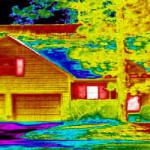|
Infrared or Thermal Imaging:
What is Thermal Imaging? Infrared Imaging or called Thermal Imaging uses the thermal or heats that every object gives off to create a picture much like a traditional camera. The difference is that the Thermal / Infrared camera does not need any visible like for the image. Using a Thermal / Infrared Camera in a property inspection is very important with today’s building. Today’ Home and Commercial building are more complicated and built much tighter than building of the past. As energy cost become more and more important building start using different methods to control heat loss and air leaking and thus not properly ventilating. This is one of the largest causes of fungal / mold growth in building today. Thermal Imaging provides the investigative power to “see” what we otherwise would miss until the issues is more significant. These images provide important information relating to otherwise inaccessible areas of a residential building and commercial building. Infrared detects extremely small differences in temperature. These small but crucial differences in temperature from one area of the building to another allow the thermographer to “see” problems with or behind the wall. . These temperature variations show up on the camera’s view screen as “cold” or “hot” spots, which reveal hidden problems that often cannot be detected in the course of a traditional visual inspection. These problems may be seen through Thermal imaging:
|
Thermal Imaging Inspection Facts:
1. Unbeatable for electrical Fault finding – There is no other technology that is able to identify such electrical faults as safely and as quickly as a survey.
2. Totally Non-intrusive – A thermographic survey is non-intrusive, meaning no disruption to normal business operations.
3. Reduction in the cost of breakdowns – As faults are found before they cause equipment to fail, the associated cost of repairs is minimal compared to the cost of equipment failure. Depending on the type of equipment and its location, the cost of electrical failure can run into many thousands of dollars in repairs, lost production, injury claims, etc.
4. Insurance Premium Reductions – Increasingly, insurance companies are reducing their premiums to companies who undertake annual surveys. Some insurance companies are now insisting on a thermal imaging survey prior to providing cover.
5. Reduction in Risk Management Contingency Budgets – Thermal surveys reduce the risk of equipment failure and the associated consequences, e.g. damage to other plant, equipment and property, injury to employees and public, operational downtime and damage to company reputation.
6. Inspections are in compliance with NFPA 70B and 70E standards with Electrical Preventive Maintenance (EPM) Program for Building Engineers and Owners to maximize uptime and reduce potential safety hazards.

